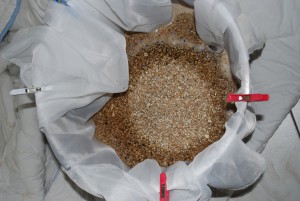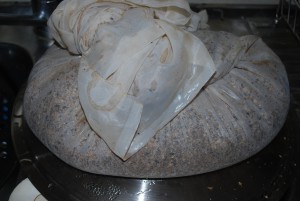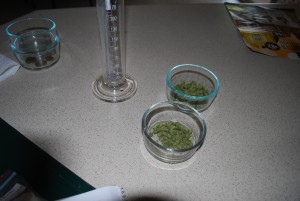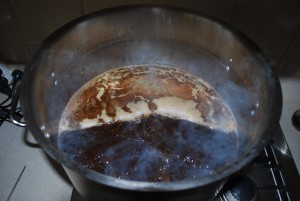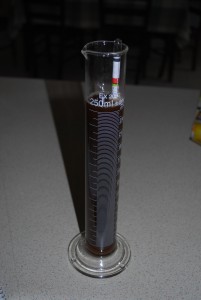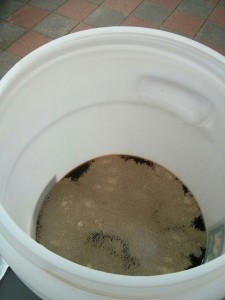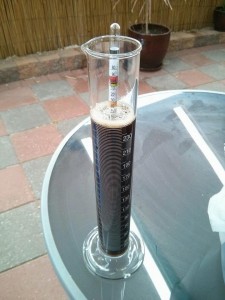It seems counter-intuitive to be brewing a stout on only the fifth day of Autumn in southern Australia as the weather is still hot, not exactly the best weather for a stout. Stouts, I am told, do benefit from a month or two in a secondary so if I want one to drink during the cooler weather now is the time to be be brewing it. Last year I brewed a “two can” stout using a can of Cooper’s Dark Ale and Cooper’s Stout and some dark malt extract and it turned out very nice but the ABV was above 8%, too much for a two pot screamer like myself. I’ll brew one of these again this year but I wanted something a bit easier to drink as well, something along the lines of a Guinness Irish Stout. The recipe on this page looked interesting so I decided to give it a go. I had to scale it down to 3 gallons (12L),to account for my BIAB efficiency (65%) and for the 5.7%AA East Kent Goldings hops I had on hand. I also wanted to add some flaked oats to the recipe for a bit of a silkier mouth feel. My trusty BIAB spreadsheet was given a workout and I arrived at the following:
Ale Maris Otter 2.4kg
Roasted Barley 0.24kg
Flaked Barley 0.16kg
CaraPils 0.16kg
Acidulated Malt 0.16kg
Flaked Oats 0.16kg
EKG 23g (5.7%AA) @ 90 minutes
EKG 8g (5.7% AA) @ 45 minutes
1/2 Whirlfloc @ 5 minutes
Nottingham Ale Yeast
Brew Type : 12L All Grain (BIAB)
OG: 1.049
FG: 1.013
ABV: 4.7%
IBU: 37.7
EBC: 76.5
I am doing no-chill again here and seeing that the hops additions are very early I am not making any hop adjustments to allow for the no chill. Given the cascading series of errors I made in the last brew I took some more care with this brew with regards to the mash volume and sparge volume. Working from my previous brews I allowed for a mash absorption of 0.7L/kg of grain. Given I wanted 12L of beer I allowed for 0.25L of fermenter loss and 0.5L of kettle loss meaning I wanted a post boil volume of 12.75L. My typical boil losses are 3L/hr so I wanted a post mash volume of 17.75L which meant a pre mash volume of 20L, split into a 15L mash and 5L sparge.
The Mash
The target mash temp was 68C and I heated 15L of strike water to 71C in my bag lined pot. Once I’d reached the temperature I poured in my crushed grains and mixed it thoroughly for a few minutes. The lid went on the pot and I wrapped it all in a thick doona. At this point the mash temperature was 68.9C. Last brew I had an awful mash efficiency which I suspected was due to not mixing the mash enough. I resolved to mix this mash every 20 minutes which I went ahead and did at 20 minutes and 40 minutes into the saccharification process. At the 40 minute point I returned the pot to my gas burner for a few minutes to bring the temperature back up to 68C. At the same time I heated 5L of sparge water to 70C.
When 60 minutes was up I collected up the edges of my brew bag and holding it with rubber gloves spun it tight to extract as much of the sweet wort as possible. Once that was done I topped my pot with a holed pizza tray that happens to fit perfectly into the opening and pressed down on the bag to extract more wort. I then put the bag straight into the 5L of sparge water and pressed down on it again to rinse off the remaining sugars before squeezing the bag again on my pizza tray topped pot and tipping in the sparge water.
The Boil
At this point I had 19L of wort in my pot, 1.25L more than I had expected. I took at gravity reading (1.031 at 53C) and brought the wort to the boil (which took about 45 minutes) before making my first 23g East Kent Goldings hop addition. The second 8g addition was made at 45 minutes and finally half a Whirlfloc tablet went in with 5 minutes remaining. At the end of the boil there was 14L of wort in the pot. The pot with lid in place was then put into my temperature controlled refrigerator to cool to pitching temperature overnight.
Fermentation
At 10AM the next day (6 March 2016) the wort was sitting at a steady 18.5C. I sterilised my fermenter and poured the wort into the vessel, took a gravity reading (1.051) and aerated thoroughly with a large sterilised plastic spoon. I pitched the Nottingham yeast, put the airlock in place on the fermenter and put it into my fermentation chamber with a set temperature of 18.5C. Funnily enough just two hours later I saw signs of fermentation in the airlock and the next morning it was bubbling vigorously.
Mash Efficiency
It appears that the steps I took to improve mash efficiency worked as I managed 75% on this brew. I did my usual calculations in Excel to arrive at the mash efficiency:
| Kg | Potential | Pounds | Potential Points | |
| Ale Maris Otter | 2.40 | 1.038 | 5.28 | 41.8 |
| Barley Roasted | 0.24 | 1.025 | 0.528 | 2.7 |
| Barley Flaked | 0.16 | 1.032 | 0.352 | 2.3 |
| CaraPils | 0.16 | 1.033 | 0.352 | 2.4 |
| Acidulated Malt | 0.16 | 1.038 | 0.352 | 2.8 |
| Oats Flaked | 0.16 | 1.037 | 0.352 | 2.7 |
| Potential | 54.82 | |||
| Actual | 41.00 | |||
| Efficiency | 74.8% |

